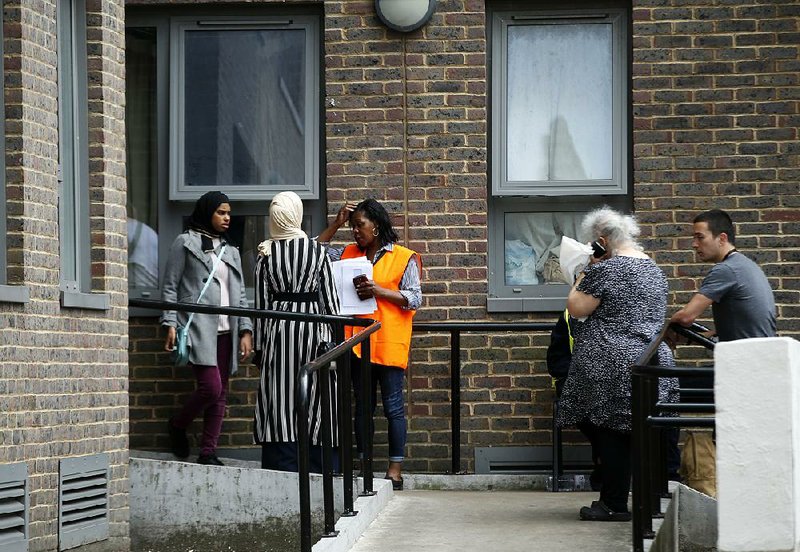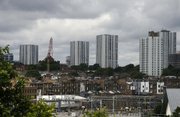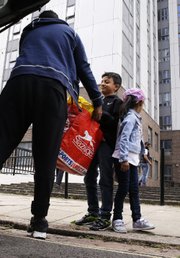LONDON -- Britain's fire safety crisis expanded Saturday as authorities said 34 high-rise apartment blocks across the country had cladding that failed fire safety tests. London officials scrambled to evacuate four public housing towers after experts found them "not safe for people to sleep in overnight."
Hundreds of residents hastily packed their bags and sought emergency shelter, with many angry and confused about the chaotic situation. Some refused to leave their high-rise apartments. Scores of evacuees slept on inflatable beds in a gym while officials sought better accommodations for them.
Camden Council leader Georgia Gould said the council decided to evacuate four blocks in north London's Chalcots Estate late Friday after fire inspectors uncovered problems with "gas insulation and door stops," which, combined with the presence of flammable cladding encasing the buildings, meant that residents had to leave immediately.
The evacuation came amid widening worries about the safety of high-rise apartment blocks across the country after the inferno that destroyed Grenfell Tower in west London on June 14, killing at least 79 people. Attention has focused on the 24-story tower's external cladding material, which has been blamed for the rapid spread of that blaze, but multiple other fire risks have now been identified in some housing blocks.
Click here for larger versions
Photos by The Associated Press
Photos by The Associated Press
The government said Saturday that the cladding samples that failed fire safety tests came from 34 apartment towers in cities including London, Manchester, Plymouth and Portsmouth. Communities Secretary Sajid Javid said further testing "is running around the clock."
So far, Camden Council is the only local authority that has asked residents to leave as a precaution. It said about 650 apartments were evacuated, though initial reports put the figure at 800 apartments.
The council said residents would be out of their homes for three to four weeks while it completes fire-safety upgrades.
"I know some residents are angry and upset, but I want to be very clear that Camden Council acted to protect them," Gould said in a statement. "Grenfell changed everything, and when told our blocks were unsafe to remain in, we acted."
Conservative Prime Minister Theresa May, who has been criticized for her slow response to the Grenfell tragedy, said Saturday that the government was supporting Camden officials to ensure that residents have somewhere to stay while building work is done.
In response, Jeremy Corbyn, leader of the opposition Labor Party, said May needed to "get a grip" and lead a stronger response to what is now a "national threat."
Residents -- including families with babies and elderly relatives -- trooped out of the buildings Friday night with suitcases and plastic bags stuffed with clothes. Council workers guided dozens to a nearby gym, where they spent the night on inflatable mattresses. Others were being put up in hotels or other housing projects.
Many residents complained about confusion and a lack of information. Officials first announced the evacuation of one building, then expanded it to five before reducing it to four. Some residents said they learned about the evacuation from television news reports just hours before officials arrived knocking on their doors.
Renee Williams, 90, who has lived in Taplow Tower since 1968, told Britain's Press Association: "No official came and told us what's going on. I saw it on the TV, so I packed an overnight bag."
"It's unbelievable. I understand that it's for our safety, but they can't just ask us to evacuate with such short notice. There's no organization, and it's chaos," she said.
Carl McDowell, 31, said he took one look at the inflatable beds in the gym and went back to his Taplow Tower apartment to sleep overnight. Other residents were distraught that they were ordered to evacuate but were told to leave their pets behind in buildings that could be dangerous.
Fire safety experts say the Grenfell Tower disaster, which police said was touched off by a faulty refrigerator, probably involved a string of failures, not just the cladding.
Police said Friday that they are considering filing manslaughter charges in the Grenfell blaze, and they were conducting a wide-ranging investigation that will look at everything that contributed to it. The Metropolitan Police said cladding attached to the Grenfell Tower during a recent renovation failed safety tests conducted by investigators.
Grenfell Tower's demise
Residents of Grenfell Tower had complained for years that the 24-story public housing block invited catastrophe. It lacked fire alarms, sprinklers and a fire escape. It had only a single staircase. And there were concerns about a new aluminum facade that was supposed to improve the building.
The facade, resident Yassin Adam said, "burned like a fire that you pour petrol on."
The facade at Grenfell Tower, installed last year in panels known as cladding and sold as Reynobond PE, consisted of two sheets of aluminum that sandwich a combustible core of polyethylene. It was produced by the U.S. manufacturing giant Alcoa, which was renamed Arconic after a reorganization last year.
Arconic has marketed the flammable facades in Britain for years, even as it has adjusted its pitch elsewhere. In other European countries, Arconic's sales materials explicitly instruct that "as soon as the building is higher than the firefighters' ladders, it has to be conceived with an incombustible material." An Arconic website for British customers said only that such use "depends on local building codes."
Adam, 44, had seen posters telling tenants to shut their doors and stay inside in the event of a fire in Grenfell Tower. But Adam, his wife, his daughter and his pregnant sister ignored the instructions and ran.
"Anyone who listened to the fire brigade and stayed where they are," Adam said in an interview, "they lost their lives."
The first call to the London Fire Brigade arrived at 12:45 a.m., according to an official statement. Six minutes later, as the first firefighters reached the scene, brigade veterans struggled to fathom the speed of the blaze.
"How is that possible?" one firefighter exclaimed, his astonishment captured in a video shot inside his vehicle as he sped toward the building.
"It has jumped all the way along the flats -- look!"
Flames in an ordinary fire burst out of windows, moving from the inside out. Grenfell Tower burned in reverse, moving inward from the building's exterior.
The original concrete structure, built in 1974 without cladding, was designed to contain a fire in one apartment long enough for firefighters to prevent it from spreading very far. But refrigerators in most apartments appear to have been positioned against an exterior wall, next to a window and just a few inches from the cladding installed in the renovation.
When a refrigerator on the fourth floor burst into flames, the fire ignited the flammable cladding and shot up the side of the building.
U.S. regulators by 1998 began requiring real-world simulations to test any materials to be used in buildings taller than a firefighter's two-story ladder. "The U.S. codes say you have to test your assembly exactly the way you install it in a building," said Robert Solomon, an engineer at the National Fire Protection Association.
No aluminum cladding made with pure polyethylene has ever passed the test, experts in the United States say. As a result, U.S. building codes have effectively banned flammable cladding in high-rises. And partly because of the influence of U.S. architects, many territories around the world follow the U.S. example. But not Britain.
The legacy of the Great Fire of London, in 1666, is still felt in Britain's building codes, experts say. The codes have focused primarily on stopping the spread of flames between buildings or, within larger structures, between units.
But as early as 1999, after a fire in a 14-story public housing block in Irvine, Scotland, British fire safety engineers warned Parliament that flammable cladding had opened a dangerous loophole in the regulations. One resident died, four others were injured, and a parliamentary committee investigated the causes.
"To a certain extent, we are hoisted by the petard of what happened here in 1666, the Great Fire of London, and we look at fire as a horizontal problem," Glynton Evans, a fire safety adviser to the firefighters union, said to Parliament. "The problem with cladding is that it will, if it is able, spread fire, and it will spread it vertically."
The firefighters and engineers warned Parliament that British codes required only that the aluminum used in cladding resist ignition, even though the heat of a fire would breach the surface and expose the flammable material inside. British rules also don't require a test to evaluate risks in real-world conditions.
But manufacturers argued against new tests or rules. Using fire-resistant materials was more expensive, a cost that industry advocates opposed.
In 2014, the Fire Protection Research Foundation, an organization in the United States, counted 20 major high-rise fires involving cladding. In at least a half-dozen, the same type of panels installed at Grenfell Tower caught fire.
A 2014 fire in Melbourne, Australia, resulted in multiple investigations into the dangers of combustible cladding. Another fire broke out in Dubai, around a 60-story skyscraper, on New Year's Eve 2015, and yet another, around a 70-story skyscraper there, in April.
But in Britain, still no changes were made.
Information for this article was contributed by Sylvia Hui, Danica Kirka, Sheila Norman-Culp, Gregory Katz and Alastair J. Grant of The Associated Press; and by David D. Kirkpatrick, Danny Hakim, James Glanz, Zephira Davis and Nour Youssef of The New York Times.
A Section on 06/25/2017


